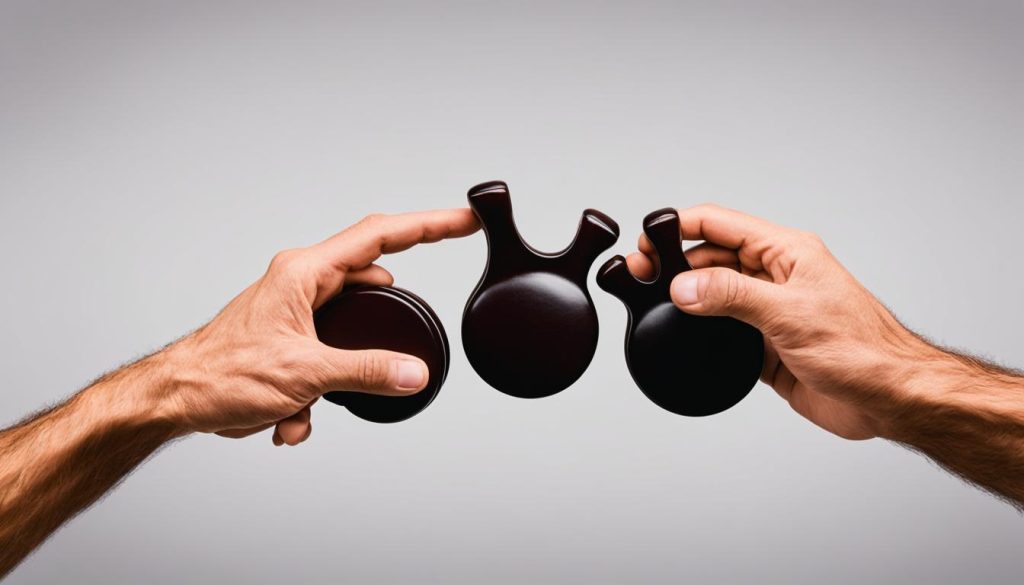Castanets are a percussion instrument often used in traditional Spanish music. If you’re curious about how are castanets played, this article will guide you through the techniques and rhythms to get you started on your castanet-playing journey.
Whether you’re a beginner looking for a step-by-step guide or an experienced player aiming to master different patterns, this article has got you covered.
When playing castanets, it’s important to choose the right size castanets that fit comfortably in your hand. The size of the castanets will also affect the tone they produce.
The castanets are played with two hands, with one set having a higher pitch and worn on the right hand, while the other set has a lower pitch and is worn on the left hand. The tightness of the castanets should be adjusted to ensure a clear and bright sound.
It’s also important to hide the castanets in your hands when performing to maintain the aesthetic. For orchestral performances, mounted castanets can be used to save time during performances.
In the next sections, we will dive into the basic techniques for beginners and explore how to master castanet playing.
Content
Basic Castanet Techniques for Beginners

Are you ready to learn the fundamental techniques of playing castanets? In this section, we will guide you step by step through the basic techniques that every beginner should know.
By mastering these techniques, you’ll be well on your way to becoming a skilled castanet player.
1. The Roll Technique
To get started, let’s practice the roll technique with the right hand. Hold the castanet in your right hand and place your fingers on top.
Begin by tapping the castanet with your pinkie finger. Then, continue tapping with your ring finger, middle finger, and pointer finger, creating a roll sound. Take your time to familiarize yourself with the rhythm and speed of the roll.
Next, let’s incorporate the left hand. Use your middle finger and ring finger of the left hand to tap the castanet at the end of each roll you make with your right hand.
This will create a slightly heavier rhythm. Practice alternating between the right and left hands, gradually increasing the speed as you gain confidence.
2. Striking Patterns
Now that you’ve got the hang of the roll technique, let’s explore different striking patterns. One simple pattern to try is the “PI” sound.
With your right hand, strike the castanet using your ring and middle fingers together. This creates a distinctive sound that can add variety to your playing.
Another striking pattern to experiment with is the “PAM” sound. Hold the castanets in both hands in front of your body and collide them together.
This will produce a rhythmic sound that adds depth to your playing. Practice controlling the volume of the “PAM” sound by adjusting the force with which you collide the castanets.
Finally, learn the finishing sound called “PAN.” To achieve this sound, strike both castanets simultaneously with your pinkie, ring, and middle fingers.
This creates a bold and resonant sound that can be used to emphasize the end of a performance or a specific musical phrase.
Your Turn to Play!
Congratulations! You’ve now learned the basic castanet techniques for beginners. Take some time to practice each technique and experiment with different striking patterns and rhythms.
Remember to start slow and gradually increase your speed as you become more comfortable.
Stay tuned for the next section, where we’ll delve deeper into mastering castanet playing. Until then, keep practicing and enjoy the rhythmic beauty of this fascinating percussion instrument.
| Technique | Description |
|---|---|
| Roll Technique | Tap the castanet with your pinkie, ring, middle, and pointer fingers to create a roll sound. Incorporate the left hand by tapping at the end of each roll. |
| Striking Patterns | Experiment with striking patterns like the “PI” sound made with the right hand and the “PAM” sound created by colliding the castanets together. Learn the finishing sound “PAN” by striking both castanets simultaneously with your pinkie, ring, and middle fingers. |
Mastering How Are Castanets Played
Now that you have mastered the basic techniques of castanet playing, it’s time to take your skills to the next level. By practicing different strikes in various patterns, you can unlock a whole new world of sounds and rhythms.
While the right hand is usually responsible for more complex rhythms, don’t be afraid to experiment with different finger strikes in different patterns to create a diverse range of tones.
Try alternating between trills and bassline strikes to add depth and variation to your playing. By clapping back and forth with different sounds, you can create dynamic and engaging rhythms.
To finish off your performance with flair, incorporate a powerful “PAN” strike that resonates throughout the room.
Furthermore, consider incorporating mounted castanets into your repertoire for orchestral performances.
These versatile instruments can be played not only with your hands but also with a drumstick or mallet, allowing you to explore different sounds and effects. The possibilities are endless when it comes to castanet patterns and techniques.
In your journey to mastering castanet playing, practice, and experimentation are key. Keep honing your skills, exploring new patterns, and pushing the boundaries of what you can achieve with this captivating instrument.
With dedication and a love for the art form, you can become a true master of castanet playing.
